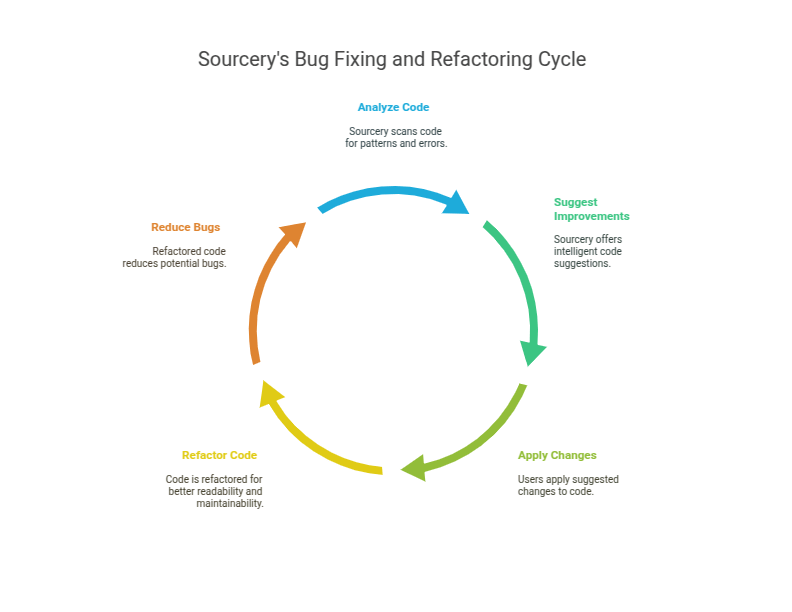Sourcery transforms Bug Fixing and Refactoring for Coders. Fix bugs faster, refactor code easily, and boost efficiency now. Try Sourcery today!
Why Sourcery Is a Game-Changer in Bug Fixing and Refactoring
Let’s talk about the grind.
You’re a developer.
You spend hours coding.
Then you spend even more hours fixing bugs.
And refactoring code.
Making it cleaner.
More efficient.
Less spaghetti-like.
It’s essential work.
But it’s also tedious.
And time-consuming.
What if there was a smarter way?
Something that cuts through the noise.
Gets you results faster.
Frees you up to build cool stuff.
Not chase down elusive bugs.
Or wrestle with legacy code.
AI is changing everything.
Especially in Coding and Developing.
Tools are popping up everywhere.
Claiming to boost your productivity.
Make your life easier.
Sourcery is one of them.
But does it deliver?
Especially for the painful parts?
Like Bug Fixing and Refactoring?
Let’s see.
Table of Contents
- What is Sourcery?
- Key Features of Sourcery for Bug Fixing and Refactoring
- Benefits of Using Sourcery for Coding and Developing
- Pricing & Plans
- Hands-On Experience / Use Cases
- Who Should Use Sourcery?
- How to Make Money Using Sourcery
- Limitations and Considerations
- Final Thoughts
- Frequently Asked Questions
What is Sourcery?
Okay, what exactly is Sourcery?
Think of it as an AI assistant for your code.
It’s designed specifically for developers.
It plugs right into your IDE.
Stuff like VS Code, PyCharm, and others.
Its main job?
To analyse your Python code.
Yes, it’s currently focused on Python.
A huge chunk of the dev world.
It looks for common issues.
Code smells.
Things that make your code harder to read.
Harder to maintain.
And potentially bug traps.
It doesn’t just point out problems.
That’s what linters do.
Sourcery offers suggestions.
Concrete ways to improve your code.
Often with a single click.
It aims to make your code cleaner.
More Pythonic.
And ultimately, more robust.
Less prone to unexpected behaviour.
Which is a big deal for Bug Fixing and Refactoring.
It’s built for coders who want to write better code.
Faster.
With less manual effort.
It’s not magic.
It’s smart analysis.
Powered by AI and a deep understanding of coding patterns.
Key Features of Sourcery for Bug Fixing and Refactoring

Let’s break down what this thing actually does.
How does it help you tackle the pain of Bug Fixing and Refactoring?
It’s got specific features built for this.
- Intelligent Code Suggestions:
This is where the magic happens.
Sourcery reads your code.
It doesn’t just check for syntax errors.
It looks at the logic.
The structure.
It identifies patterns that could be simplified.
Or written more clearly.
Like redundant variable assignments.
Or overly complex conditional statements.
It spots potential runtime errors before they happen.
Things that might only surface with specific inputs.
By suggesting cleaner, more direct code, it proactively fixes potential bugs.
And makes future Bug Fixing and Refactoring way easier.
Less code is less surface area for bugs.
- Automated Refactoring:
This is a massive time saver.
Sourcery doesn’t just tell you what to change.
It often gives you the option to change it automatically.
With a single click or keyboard shortcut.
Imagine seeing a messy loop.
Sourcery identifies a more Pythonic way to write it.
Maybe using a list comprehension.
You hit ‘apply suggestion’.
Boom. Done.
This isn’t just cosmetic.
Refactored code is usually more readable.
More maintainable.
And less likely to hide bugs.
It means you spend less time manually rewriting code.
And more time building.
This accelerates your Bug Fixing and Refactoring cycles significantly.
You tackle technical debt proactively.
- Context-Aware Analysis:
Sourcery understands the code around the part it’s analysing.
It doesn’t just apply generic rules.
It considers the function, the class, the module.
This makes its suggestions more relevant.
And less likely to break things.
It helps avoid the classic problem with automated tools.
Where they suggest changes that don’t fit the specific context.
This intelligent analysis means the suggestions it gives you for Bug Fixing and Refactoring are usually spot on.
You spend less time reviewing bad suggestions.
And more time applying good ones.
It helps you write code that’s not just correct, but also aligns with best practices for your specific project.
Reducing future bugs and the need for extensive manual refactoring.
Benefits of Using Sourcery for Coding and Developing
Okay, so it does stuff.
But what’s the actual upside for you?
Why bother integrating another tool?
Especially for the often tedious work of Bug Fixing and Refactoring?
Let’s talk benefits.
Real-world benefits you’ll see in your day-to-day work.
You save time. A LOT of time.
Think about it.
Manually identifying code smells takes time.
Hunting down the root cause of a bug takes time.
Manually rewriting code to make it cleaner takes time.
Sourcery automates huge chunks of this.
It highlights issues instantly as you type.
It suggests fixes and refactors often with one click.
This isn’t just marginal improvement.
It’s like getting a productivity superpower.
Time saved on fixing old code means time gained for writing new code.
Or building new features.
Or even just finishing work on time.
Your code quality shoots up.
Sourcery enforces best practices.
It pushes you towards more Pythonic, readable code.
Cleaner code is easier to understand.
Easier for your teammates to work with.
And crucially, less prone to bugs.
By reducing complexity and improving structure, you reduce the surface area for errors.
This means fewer bugs introduced in the first place.
And when bugs do appear, the clean code makes them easier to find and fix.
This is fundamental to effective Bug Fixing and Refactoring.
You overcome “developer block”.
Sometimes you look at a messy piece of code.
And you just don’t know where to start refactoring.
It feels overwhelming.
Sourcery gives you concrete, actionable steps.
“Here’s a simplification you can make.”
“This pattern could be cleaner.”
It breaks down the big task into smaller, manageable improvements.
This makes the job feel less daunting.
And helps you get started.
Which is often the hardest part.
It provides a roadmap for improving your codebase.
Reduced mental overhead.
You don’t have to constantly keep thousands of code patterns and best practices in your head.
Sourcery does the heavy lifting.
It’s like having an expert code reviewer looking over your shoulder 24/7.
But without the awkward meetings.
This frees up your brainpower for solving the actual, complex problems.
The business logic.
The architecture.
Not remembering the most Pythonic way to swap two variables.
This reduces cognitive load and makes coding feel less like a chore.
Making Bug Fixing and Refactoring less draining.
Faster onboarding for new team members.
When new developers join your team, they might not be familiar with your specific coding standards.
Or even just general Python best practices.
Sourcery acts as a constant guide.
It gently nudges them towards writing better code from day one.
This reduces the amount of time senior developers need to spend on code reviews focused on style and common patterns.
It helps maintain consistency across the codebase.
Making Bug Fixing and Refactoring a team effort, guided by the tool.
Stay ahead of technical debt.
Technical debt is like interest on a loan.
The longer you leave it, the more it costs you.
Messy code accumulates problems over time.
Sourcery helps you chip away at this constantly.
By suggesting improvements as you work.
It prevents small issues from growing into massive Bug Fixing and Refactoring nightmares.
This means less time dedicated to painful clean-up sprints later on.
It’s proactive maintenance.
Pricing & Plans

Alright, so it sounds good.
But how much does it cost?
Is it going to break the bank?
Sourcery has a few different options.
They know developers work in different setups.
Solo. Teams. Big companies.
They typically offer a free tier.
This is great for individuals.
Or for just trying it out.
The free plan usually gives you access to the core features.
The intelligent suggestions.
The automated refactoring for common patterns.
It’s enough to see the value.
And improve your own personal projects or small codebase.
For more serious use, especially in teams or on larger projects, you’ll look at paid plans.
These usually offer more.
More advanced suggestions.
Deeper analysis.
Integration with Git and CI/CD pipelines.
Team features like shared rules and reporting.
Collaboration is key in Coding and Developing.
Paid plans make Sourcery a team asset.
Pricing varies depending on the number of users.
And the features you need.
Compared to other tools?
Standard linters are often free, but they don’t offer the same level of intelligent suggestions or automated refactoring.
Other AI coding assistants might be broader.
Suggesting code snippets, generating documentation, etc.
Sourcery is highly focused on code quality, Bug Fixing and Refactoring.
Its pricing reflects that specialisation.
You’re paying for deeply specific, valuable suggestions.
That directly impact code health and maintenance costs.
Think about the cost of a single critical bug making it to production.
Or the hours spent on manual Bug Fixing and Refactoring every week.
The cost of Sourcery looks pretty reasonable when you stack it up against those numbers.
It’s an investment in better code and faster development cycles.
Hands-On Experience / Use Cases
Enough theory.
What’s it actually like to use this thing?
I plugged Sourcery into my VS Code setup.
Working on a messy Python script.
Something I’d written quickly a while back.
Full of quick-and-dirty fixes and duplicated logic.
Sourcery started highlighting things immediately.
Underlining sections of code.
Hovering over the underline showed a suggestion.
Like, “This loop could be a list comprehension.”
Or, “You can simplify this `if/else` block.”
Next to the suggestion, there was a button.
“Apply suggestion”.
One click.
The code changed.
Instantly.
It felt powerful.
Instead of thinking, “Okay, how do I rewrite this loop?”
Or, “Is there a cleaner way to do this?”
Sourcery showed me the way.
And did the typing for me.
It was like having an experienced pair programmer next to me.
Pointing out improvements constantly.
Use case 1: Cleaning up legacy code.
We all have that old project.
Full of code nobody wants to touch.
Sourcery is perfect for this.
Just open the files.
Let Sourcery analyse.
It will start finding low-hanging fruit for refactoring.
Simple improvements that reduce complexity.
Making the code less scary to work with.
This directly helps with future Bug Fixing and Refactoring efforts in that code.
Use case 2: Proactive Bug Fixing and Refactoring.
Write code as you normally would.
Have Sourcery running in the background.
As soon as you write something that could be improved or is potentially buggy…
Sourcery flags it.
You fix it right away.
Before it even gets committed.
This prevents bugs from ever entering the codebase.
Much cheaper than finding them later.
It’s like automated quality control baked into your workflow.
Use case 3: Learning Pythonic ways.
If you’re newer to Python, or just want to improve your style…
Sourcery shows you how the pros write code.
It suggests patterns that are idiomatic Python.
List comprehensions, generator expressions, f-strings, etc.
You learn by doing.
And by seeing the suggested improvements.
This makes you a better coder over time.
Which is the best long-term strategy for reducing Bug Fixing and Refactoring pain.
The usability is excellent.
It integrates seamlessly into major IDEs.
The suggestions are usually clear and easy to understand.
The ability to apply fixes instantly is a killer feature.
It felt genuinely helpful.
Not like just another noisy linter.
It felt like a tool actively helping me improve my code.
And making the necessary evils of Bug Fixing and Refactoring much less painful.
Who Should Use Sourcery?

Is this tool for everyone?
If you write Python code, probably yes.
But let’s get more specific.
Who benefits most from Sourcery?
Individual Developers:
Coding solo?
Working on side projects?
Sourcery is your personal code reviewer.
It helps you write better code even without a team to check it.
It catches mistakes you might miss.
It pushes you to use better patterns.
This means fewer bugs in your personal projects.
And a better portfolio if you’re looking for jobs.
It directly helps you with Bug Fixing and Refactoring on your own.
Development Teams:
This is where Sourcery really shines.
Maintaining code quality across a team is hard.
Everyone has slightly different habits.
Sourcery provides a consistent standard.
It helps enforce best practices automatically.
This reduces friction in code reviews.
Reviewers can focus on logic, not style or common patterns.
It means less time spent on mundane fixes.
More time shipping features.
And a codebase that’s easier for the whole team to navigate and manage.
Making team-based Bug Fixing and Refactoring much more efficient.
Open Source Contributors:
Contributing to open source requires adhering to project standards.
Sourcery helps you submit pull requests with cleaner code.
Reducing the back-and-forth on style issues.
Making your contributions more likely to be accepted.
It helps you learn the common patterns used in popular libraries.
Students and Learners:
Learning to code is tough.
Learning to write *good* code is even tougher.
Sourcery acts as a constant teacher.
It shows you better ways to write code in real-time.
It helps you build good habits from the start.
Learning about Bug Fixing and Refactoring patterns early on saves years of pain.
Companies (Small to Large):
Code quality is critical for businesses.
Bugs cost money.
Messy code slows down development.
Sourcery helps companies maintain a healthy codebase.
Reduce the cost of Bug Fixing and Refactoring.
Improve developer productivity.
Ensure consistency across projects.
It’s an investment that pays off in reduced maintenance costs and faster feature delivery.
If your work involves Python and you care about writing clean, maintainable code, Sourcery is worth looking at.
Especially if you find yourself spending too much time on Bug Fixing and Refactoring.
How to Make Money Using Sourcery
Okay, the tool helps you.
But can you turn its power into actual income?
Absolutely.
Not directly by selling Sourcery itself, obviously.
But by leveraging the efficiency and quality it gives you.
Think about what Sourcery does.
It makes you faster at writing good Python code.
It drastically speeds up Bug Fixing and Refactoring.
This is valuable.
Here’s how you can monetize that value:
- Offer Code Refactoring Services:
Lots of businesses have old, messy Python codebases.
They know it’s a problem.
But they don’t have the time or internal expertise to clean it up.
You can offer services specifically for refactoring Python code.
Use Sourcery to quickly identify areas for improvement.
And apply automated fixes.
This makes your work faster.
You can charge a premium for the improved quality.
Or charge less than someone doing it manually, winning more business.
Clients get cleaner, more maintainable code faster.
You make money by being efficient.
- Provide Bug Fixing and Refactoring Support Packages:
Companies often need ongoing support for their software.
Bugs pop up.
Code needs minor tweaks.
You can offer retainers or per-incident support.
Use Sourcery to diagnose issues faster.
Identify the root cause of bugs by understanding the surrounding code better.
Apply fixes and refactors quickly.
This allows you to handle more support requests.
Or charge a higher rate for faster resolution times.
Your efficiency using Sourcery directly translates to more billable hours or more clients served.
- Develop and Sell High-Quality Python Libraries or Applications:
When you build your own products, quality matters.
A well-written library with minimal bugs is more likely to be adopted.
A robust application attracts more customers.
Using Sourcery ensures your code is clean, maintainable, and less prone to errors from the start.
This reduces post-launch Bug Fixing and Refactoring.
Saving you time and resources.
Allows you to focus on adding features.
The higher quality of your product is a selling point.
And reduces the cost of supporting it long-term.
You profit from the efficiency and quality gains Sourcery provides during development.
Case Study Idea (Hypothetical): How Jane Doe Makes $5k/Month Refactoring Code with Sourcery.
Jane was a freelance Python developer.
She spent a lot of time cleaning up client codebases.
It was slow, manual work.
She started using Sourcery.
It helped her identify and fix code smells 3x faster.
She could take on more projects.
She started marketing herself specifically for “Python Codebase Tune-Ups” and “Technical Debt Reduction”.
She charges based on project complexity, but her increased speed means her hourly effective rate went way up.
Clients are happy because they get cleaner code quicker.
Jane makes significantly more money by leveraging Sourcery’s efficiency.
It’s not about the tool doing the work for you entirely.
It’s about the tool making *your* work faster and higher quality.
That efficiency is a direct path to increased earnings.
Limitations and Considerations
Alright, let’s be real.
No tool is perfect.
Sourcery is powerful.
Especially for Bug Fixing and Refactoring in Python.
But it’s not a magic bullet.
Here are some things to keep in mind.
It’s Focused on Python:
This is a big one.
If you code in Java, JavaScript, Go, etc., Sourcery isn’t for you.
Its expertise is currently limited to the Python language.
This might change in the future, but for now, it’s Python-only.
Suggestions Need Review:
Sourcery’s suggestions are usually good.
But they aren’t always perfect.
Sometimes a suggested refactor might not fit the specific logic or context you intended.
You still need to understand the code.
And understand the suggestion.
And verify it does what you want.
Blindly applying every suggestion is a recipe for disaster.
It’s an assistant, not a replacement for your brain.
This is crucial for Bug Fixing and Refactoring – you need to understand *why* something is a bug or messy.
Doesn’t Understand Business Logic:
Sourcery analyses code patterns.
It doesn’t understand the higher-level purpose of your application.
It won’t tell you if your algorithm is wrong for the business problem.
Or if you should be using a different data structure based on requirements.
It’s focused on the code itself, not the problem the code is solving.
Bug Fixing and Refactoring often require deep understanding of requirements.
Sourcery helps with the ‘how’ of writing good code, not the ‘what’ or ‘why’.
May Require Learning Curve (Initially):
Integrating it into your IDE is usually easy.
But understanding *why* Sourcery is suggesting something can take time.
Especially if you’re not familiar with the Pythonic patterns it promotes.
It can feel overwhelming at first seeing lots of suggestions.
You need to learn to prioritize and understand the value of each type of suggestion.
This isn’t a steep curve, but it’s not zero.
Potential Over-Optimization:
Sometimes the most “Pythonic” or concise code isn’t the most readable for everyone.
Sourcery tends to push towards conciseness.
Which is often good.
But you need to consider your team’s comfort level and coding standards.
Don’t sacrifice readability for a slightly shorter line of code just because Sourcery suggested it.
Maintainability is a key goal of Bug Fixing and Refactoring, and readability is part of that.
Ultimately, Sourcery is a tool to augment your skills.
Not replace them.
It makes you faster and helps you write better code.
But you are still the developer.
You make the final decisions.
Final Thoughts
So, where does Sourcery fit in?
If you’re a Python developer, this tool is seriously worth considering.
Especially if you’re tired of the manual grind of Bug Fixing and Refactoring.
It’s like having a dedicated expert constantly reviewing your code.
Offering specific, actionable ways to make it better.
It saves you time.
It improves code quality.
It helps you write more Pythonic code.
And for teams, it promotes consistency and reduces review friction.
Does it fix *every* bug?
No.
Does it refactor complex architecture for you?
No.
But it handles a huge volume of the common, repetitive tasks involved in keeping code clean and reducing simple errors.
The kind of stuff that eats up your day.
The kind of stuff that makes Bug Fixing and Refactoring a chore.
It allows you to focus on the harder problems.
The interesting challenges.
Not wrestling with formatting or redundant logic.
Is it a game-changer?
For many Python developers, especially those dealing with significant Bug Fixing and Refactoring work, yes.
The efficiency gains are real.
The improvement in code quality is tangible.
I’d recommend trying the free tier.
Plug it into your IDE.
Let it analyse some of your existing code.
See what it finds.
Try applying a few suggestions.
See how it feels.
You might be surprised at how much time and effort it saves you.
And how much cleaner your code becomes.
Making that dreaded Bug Fixing and Refactoring work significantly less painful.
Visit the official Sourcery website
Frequently Asked Questions
1. What is Sourcery used for?
Sourcery is an AI-powered tool for Python developers.
It analyses your code in real-time.
It suggests improvements to make it cleaner, more Pythonic, and less prone to bugs.
Its main uses are improving code quality, speeding up Bug Fixing and Refactoring, and learning best practices.
2. Is Sourcery free?
Sourcery offers a free tier for individual use.
This plan includes core features for getting suggestions and automated refactoring.
They also have paid plans for teams and more advanced features, like deeper analysis and CI/CD integration.
3. How does Sourcery compare to other AI tools?
While some AI tools generate code or documentation, Sourcery is highly specialised.
It focuses specifically on code quality analysis, suggesting improvements, and automated refactoring for Python.
It complements tools like linters and formatters by providing more intelligent, context-aware suggestions.
It’s less about writing code for you and more about helping you improve the code you’ve written.
4. Can beginners use Sourcery?
Yes, beginners can definitely use Sourcery.
It can be a great learning tool.
It shows you how to write more Pythonic and efficient code by suggesting better patterns.
It helps build good coding habits from the start, reducing common early mistakes.
5. Does the content created by Sourcery meet quality and optimization standards?
Sourcery doesn’t create content like articles or marketing copy.
It works with code.
The code it helps you produce meets high quality standards.
It promotes clean, maintainable, and efficient code.
This helps with code optimization by reducing complexity and improving performance in many cases.
6. Can I make money with Sourcery?
You can make money by using Sourcery to boost your productivity and the quality of your work.
This includes offering services like Python code refactoring or Bug Fixing and Refactoring.
It also helps you build higher-quality software products or libraries faster.
Your efficiency gains directly translate to more capacity and better results for clients or your own projects.






